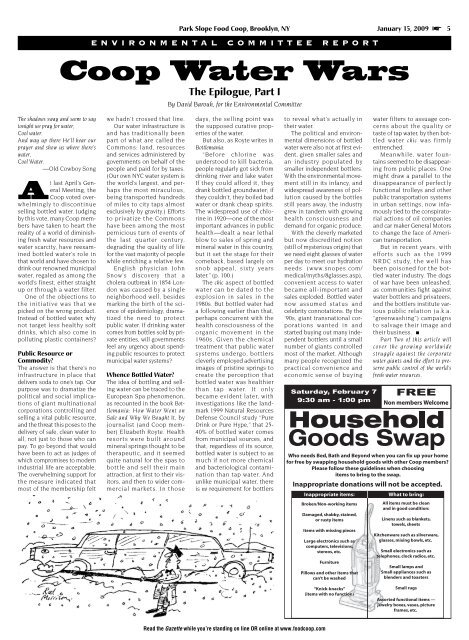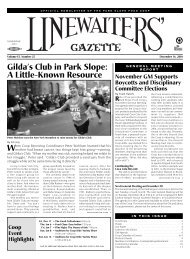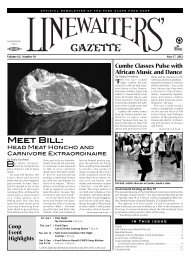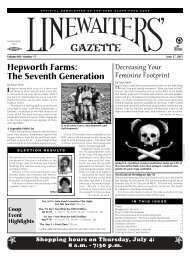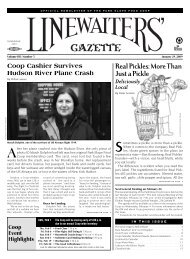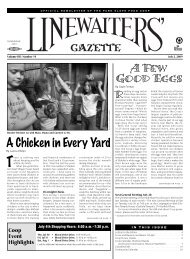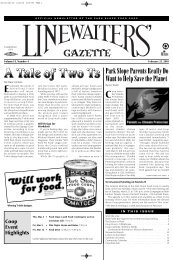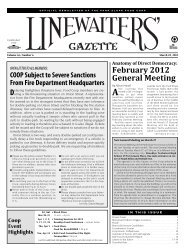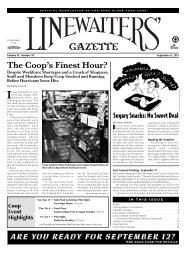The Coop in the Classroom - Park Slope Food Coop
The Coop in the Classroom - Park Slope Food Coop
The Coop in the Classroom - Park Slope Food Coop
You also want an ePaper? Increase the reach of your titles
YUMPU automatically turns print PDFs into web optimized ePapers that Google loves.
09-01-15 p 01-16 1/14/09 6:37 PM Page 5<br />
<strong>Park</strong> <strong>Slope</strong> <strong>Food</strong> <strong>Coop</strong>, Brooklyn, NY January 15, 2009 5<br />
ENVIRONMENTAL COMMITTEE REPORT<br />
<strong>Coop</strong> Water Wars<br />
<strong>The</strong> Epilogue, Part I<br />
By David Barouh, for <strong>the</strong> Environmental Committee<br />
<strong>The</strong> shadows sway and seem to say<br />
tonight we pray for water,<br />
Cool water.<br />
And way up <strong>the</strong>re He’ll hear our<br />
prayer and show us where <strong>the</strong>re’s<br />
water,<br />
Cool Water.<br />
—Old Cowboy Song<br />
At last April’s General<br />
Meet<strong>in</strong>g, <strong>the</strong><br />
<strong>Coop</strong> voted overwhelm<strong>in</strong>gly<br />
to discont<strong>in</strong>ue<br />
sell<strong>in</strong>g bottled water. Judg<strong>in</strong>g<br />
by this vote, many <strong>Coop</strong> members<br />
have taken to heart <strong>the</strong><br />
reality of a world of dim<strong>in</strong>ish<strong>in</strong>g<br />
fresh water resources and<br />
water scarcity, have reexam<strong>in</strong>ed<br />
bottled water’s role <strong>in</strong><br />
that world and have chosen to<br />
dr<strong>in</strong>k our renowned municipal<br />
water, regaled as among <strong>the</strong><br />
world’s f<strong>in</strong>est, ei<strong>the</strong>r straight<br />
up or through a water filter.<br />
One of <strong>the</strong> objections to<br />
<strong>the</strong> <strong>in</strong>itiative was that we<br />
picked on <strong>the</strong> wrong product.<br />
Instead of bottled water, why<br />
not target less healthy soft<br />
dr<strong>in</strong>ks, which also come <strong>in</strong><br />
pollut<strong>in</strong>g plastic conta<strong>in</strong>ers<br />
Public Resource or<br />
Commodity<br />
<strong>The</strong> answer is that <strong>the</strong>re’s no<br />
<strong>in</strong>frastructure <strong>in</strong> place that<br />
delivers soda to one’s tap. Our<br />
purpose was to dramatize <strong>the</strong><br />
political and social implications<br />
of giant mult<strong>in</strong>ational<br />
corporations controll<strong>in</strong>g and<br />
sell<strong>in</strong>g a vital public resource,<br />
and <strong>the</strong> threat this poses to <strong>the</strong><br />
delivery of safe, clean water to<br />
all, not just to those who can<br />
pay. To go beyond that would<br />
have been to act as judges of<br />
which compromises to modern<br />
<strong>in</strong>dustrial life are acceptable.<br />
<strong>The</strong> overwhelm<strong>in</strong>g support for<br />
<strong>the</strong> measure <strong>in</strong>dicated that<br />
most of <strong>the</strong> membership felt<br />
we hadn’t crossed that l<strong>in</strong>e.<br />
Our water <strong>in</strong>frastructure is<br />
and has traditionally been<br />
part of what are called <strong>the</strong><br />
Commons: land, resources<br />
and services adm<strong>in</strong>istered by<br />
governments on behalf of <strong>the</strong><br />
people and paid for by taxes.<br />
(Our own NYC water system is<br />
<strong>the</strong> world’s largest, and perhaps<br />
<strong>the</strong> most miraculous,<br />
be<strong>in</strong>g transported hundreds<br />
of miles to city taps almost<br />
exclusively by gravity.) Efforts<br />
to privatize <strong>the</strong> Commons<br />
have been among <strong>the</strong> most<br />
pernicious turn of events of<br />
<strong>the</strong> last quarter century,<br />
degrad<strong>in</strong>g <strong>the</strong> quality of life<br />
for <strong>the</strong> vast majority of people<br />
while enrich<strong>in</strong>g a relative few.<br />
English physician John<br />
Snow’s discovery that a<br />
cholera outbreak <strong>in</strong> 1854 London<br />
was caused by a s<strong>in</strong>gle<br />
neighborhood well, besides<br />
mark<strong>in</strong>g <strong>the</strong> birth of <strong>the</strong> science<br />
of epidemiology, dramatized<br />
<strong>the</strong> need to protect<br />
public water. If dr<strong>in</strong>k<strong>in</strong>g water<br />
comes from bottles sold by private<br />
entities, will governments<br />
feel any urgency about spend<strong>in</strong>g<br />
public resources to protect<br />
municipal water systems<br />
Whence Bottled Water<br />
<strong>The</strong> idea of bottl<strong>in</strong>g and sell<strong>in</strong>g<br />
water can be traced to <strong>the</strong><br />
European Spa phenomenon,<br />
as recounted <strong>in</strong> <strong>the</strong> book Bottlemania:<br />
How Water Went on<br />
Sale and Why We Bought It, by<br />
journalist (and <strong>Coop</strong> member)<br />
Elizabeth Royte. Health<br />
resorts were built around<br />
m<strong>in</strong>eral spr<strong>in</strong>gs thought to be<br />
<strong>the</strong>rapeutic, and it seemed<br />
quite natural for <strong>the</strong> spas to<br />
bottle and sell <strong>the</strong>ir ma<strong>in</strong><br />
attraction, at first to <strong>the</strong>ir visitors,<br />
and <strong>the</strong>n to wider commercial<br />
markets. In those<br />
days, <strong>the</strong> sell<strong>in</strong>g po<strong>in</strong>t was<br />
<strong>the</strong> supposed curative properties<br />
of <strong>the</strong> water.<br />
But also, as Royte writes <strong>in</strong><br />
Bottlemania:<br />
“Before chlor<strong>in</strong>e was<br />
understood to kill bacteria,<br />
people regularly got sick from<br />
dr<strong>in</strong>k<strong>in</strong>g river and lake water.<br />
If <strong>the</strong>y could afford it, <strong>the</strong>y<br />
drank bottled groundwater; if<br />
<strong>the</strong>y couldn’t, <strong>the</strong>y boiled bad<br />
water or drank cheap spirits.<br />
<strong>The</strong> widespread use of chlor<strong>in</strong>e<br />
<strong>in</strong> 1920—one of <strong>the</strong> most<br />
important advances <strong>in</strong> public<br />
health—dealt a near lethal<br />
blow to sales of spr<strong>in</strong>g and<br />
m<strong>in</strong>eral water <strong>in</strong> this country,<br />
but it set <strong>the</strong> stage for <strong>the</strong>ir<br />
comeback, based largely on<br />
snob appeal, sixty years<br />
later.” (p. 100.)<br />
<strong>The</strong> chic aspect of bottled<br />
water can be dated to <strong>the</strong><br />
explosion <strong>in</strong> sales <strong>in</strong> <strong>the</strong><br />
1980s. But bottled water had<br />
a follow<strong>in</strong>g earlier than that,<br />
perhaps concurrent with <strong>the</strong><br />
health consciousness of <strong>the</strong><br />
organic movement <strong>in</strong> <strong>the</strong><br />
1960s. Given <strong>the</strong> chemical<br />
treatment that public water<br />
systems undergo, bottlers<br />
cleverly employed advertis<strong>in</strong>g<br />
images of prist<strong>in</strong>e spr<strong>in</strong>gs to<br />
create <strong>the</strong> perception that<br />
bottled water was healthier<br />
than tap water. It only<br />
became evident later, with<br />
<strong>in</strong>vestigations like <strong>the</strong> landmark<br />
1999 Natural Resources<br />
Defense Council study “Pure<br />
Dr<strong>in</strong>k or Pure Hype,” that 25-<br />
40% of bottled water comes<br />
from municipal sources, and<br />
that, regardless of its source,<br />
bottled water is subject to as<br />
much if not more chemical<br />
and bacteriological contam<strong>in</strong>ation<br />
than tap water. And<br />
unlike municipal water, <strong>the</strong>re<br />
is no requirement for bottlers<br />
to reveal what’s actually <strong>in</strong><br />
<strong>the</strong>ir water.<br />
<strong>The</strong> political and environmental<br />
dimensions of bottled<br />
water were also not at first evident,<br />
given smaller sales and<br />
an <strong>in</strong>dustry populated by<br />
smaller <strong>in</strong>dependent bottlers.<br />
With <strong>the</strong> environmental movement<br />
still <strong>in</strong> its <strong>in</strong>fancy, and<br />
widespread awareness of pollution<br />
caused by <strong>the</strong> bottles<br />
still years away, <strong>the</strong> <strong>in</strong>dustry<br />
grew <strong>in</strong> tandem with grow<strong>in</strong>g<br />
health consciousness and<br />
demand for organic produce.<br />
With <strong>the</strong> cleverly marketed<br />
but now discredited notion<br />
(still of mysterious orig<strong>in</strong>) that<br />
we need eight glasses of water<br />
per day to meet our hydration<br />
needs (www.snopes.com/<br />
medical/myths/8glasses.asp),<br />
convenient access to water<br />
became all-important and<br />
sales exploded. Bottled water<br />
now assumed status and<br />
celebrity connotations. By <strong>the</strong><br />
‘90s, giant transnational corporations<br />
wanted <strong>in</strong> and<br />
started buy<strong>in</strong>g out many <strong>in</strong>dependent<br />
bottlers until a small<br />
number of giants controlled<br />
most of <strong>the</strong> market. Although<br />
many people recognized <strong>the</strong><br />
practical convenience and<br />
economic sense of buy<strong>in</strong>g<br />
water filters to assuage concerns<br />
about <strong>the</strong> quality or<br />
taste of tap water, by <strong>the</strong>n bottled<br />
water chic was firmly<br />
entrenched.<br />
Meanwhile, water founta<strong>in</strong>s<br />
seemed to be disappear<strong>in</strong>g<br />
from public places. One<br />
might draw a parallel to <strong>the</strong><br />
disappearance of perfectly<br />
functional trolleys and o<strong>the</strong>r<br />
public transportation systems<br />
<strong>in</strong> urban sett<strong>in</strong>gs, now <strong>in</strong>famously<br />
tied to <strong>the</strong> conspiratorial<br />
actions of oil companies<br />
and car maker General Motors<br />
to change <strong>the</strong> face of American<br />
transportation.<br />
But <strong>in</strong> recent years, with<br />
efforts such as <strong>the</strong> 1999<br />
NRDC study, <strong>the</strong> well has<br />
been poisoned for <strong>the</strong> bottled<br />
water <strong>in</strong>dustry. <strong>The</strong> dogs<br />
of war have been unleashed,<br />
as communities fight aga<strong>in</strong>st<br />
water bottlers and privateers,<br />
and <strong>the</strong> bottlers <strong>in</strong>stitute various<br />
public relation (a.k.a.<br />
“greenwash<strong>in</strong>g”) campaigns<br />
to salvage <strong>the</strong>ir image and<br />
<strong>the</strong>ir bus<strong>in</strong>ess. ■<br />
Part Two of this article will<br />
cover <strong>the</strong> grow<strong>in</strong>g worldwide<br />
struggle aga<strong>in</strong>st <strong>the</strong> corporate<br />
water giants and <strong>the</strong> effort to preserve<br />
public control of <strong>the</strong> world’s<br />
fresh water resources.<br />
Read <strong>the</strong> Gazette while you’re stand<strong>in</strong>g on l<strong>in</strong>e OR onl<strong>in</strong>e at www.foodcoop.com


